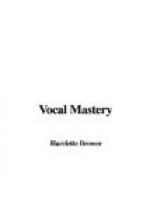IMITATION A FUNDAMENTAL PRINCIPLE
“If you are interested, I will go a little more into detail. The main idea of this unique method of study, is imitation. Every human being likes to imitate—from the tiny child to the adult. Acting upon this idea, we take the artist as model. Everything the model does, the student strives to imitate. By means of the record, it is possible for the student to do this over and over again, until he has learned to copy it as accurately as it is possible. And here is where the knowledge and experience of the teacher come in. During the lesson he tests each tone, each phrase, advising the pupil how nearly he approaches the perfect model, or showing him his faults and why he does not succeed in imitating the model more correctly.”
FOR BEGINNERS
“Do you mean to say, Mr. Saenger, that this method of vocal study can be taken up by one who knows really nothing of the voice, or singing, and can be used with success; that such a person can become a singer through self-study?”
“It is indeed possible,” was the answer; “and it is being done every day. If the student has much intelligence, determination and concentration, she can learn to sing from these directions and these records. They are a great boon to young aspirants in small towns, where there are really no good teachers. In such places local teachers can study and teach from these records.
“Again, you often find people too shy, or too ashamed to go to a teacher for a voice trial or lessons. They want to sing—every one would like to do that; but they don’t know how to go at it. With these records they can begin to study, and thus get ready for later lessons. With these records those who are far from a music center can have the benefit of expert instruction at small cost. I might work with a pupil for several months in the ordinary way—without the records—and not be able to teach him even with half the accuracy and quickness obtainable by the new method.
THE ACCOMPANIST
“All singers know how important, how necessary it is to have services of an expert accompanist. The student of this method has one at hand every hour of the day; a tireless accompanist, who is willing to repeat without complaint, as often as necessary.
THE SPEAKING VOICE
“A very important branch of the work, for the would-be singer, is to cultivate the speaking voice. Tones in speaking should always be made beautiful and resonant. Even in children a pleasant quality of voice in speaking can be acquired. Mothers and teachers can be trained to know and produce beautiful tones. The ear must be cultivated to know a pure, beautiful tone and to love it.




